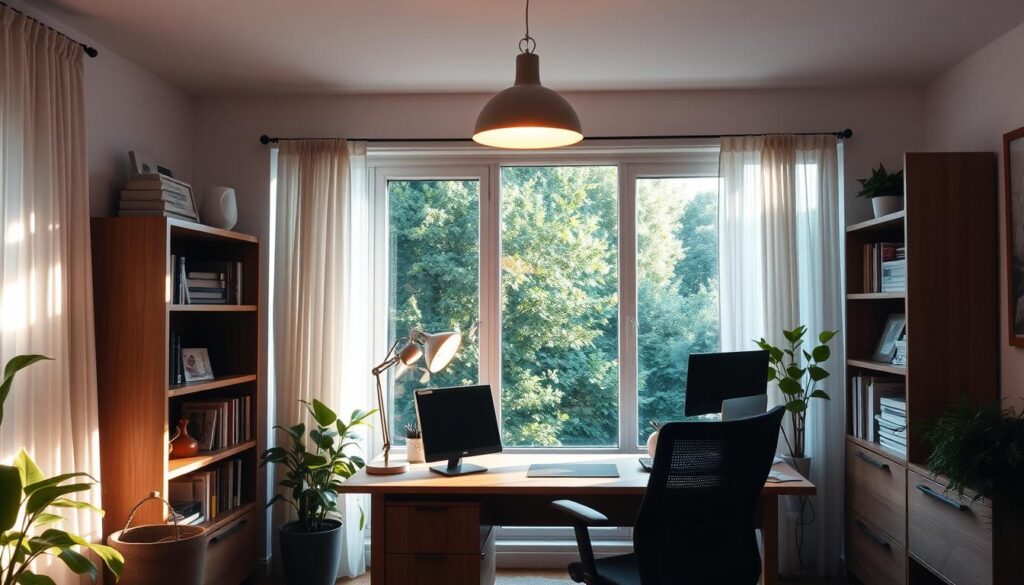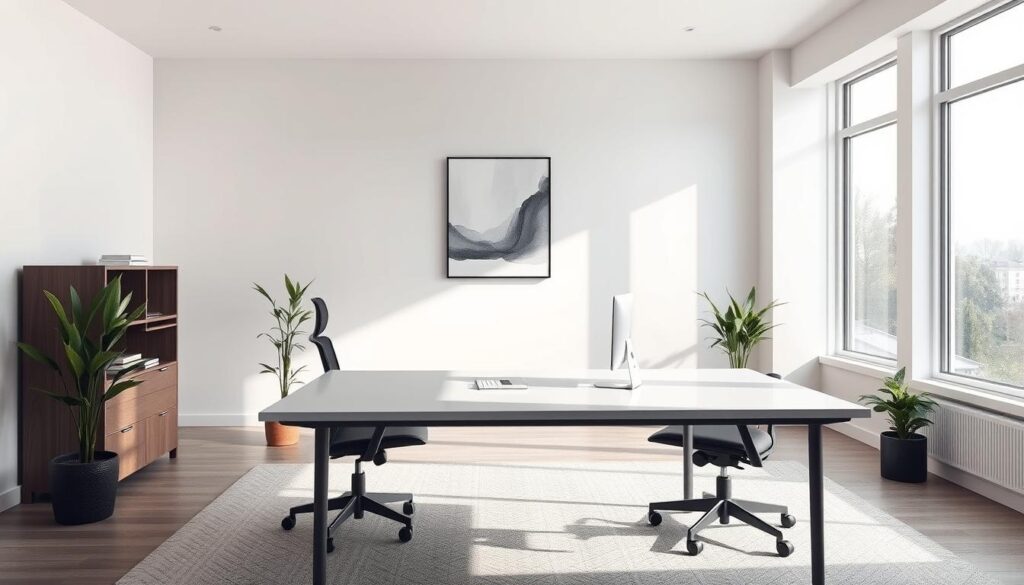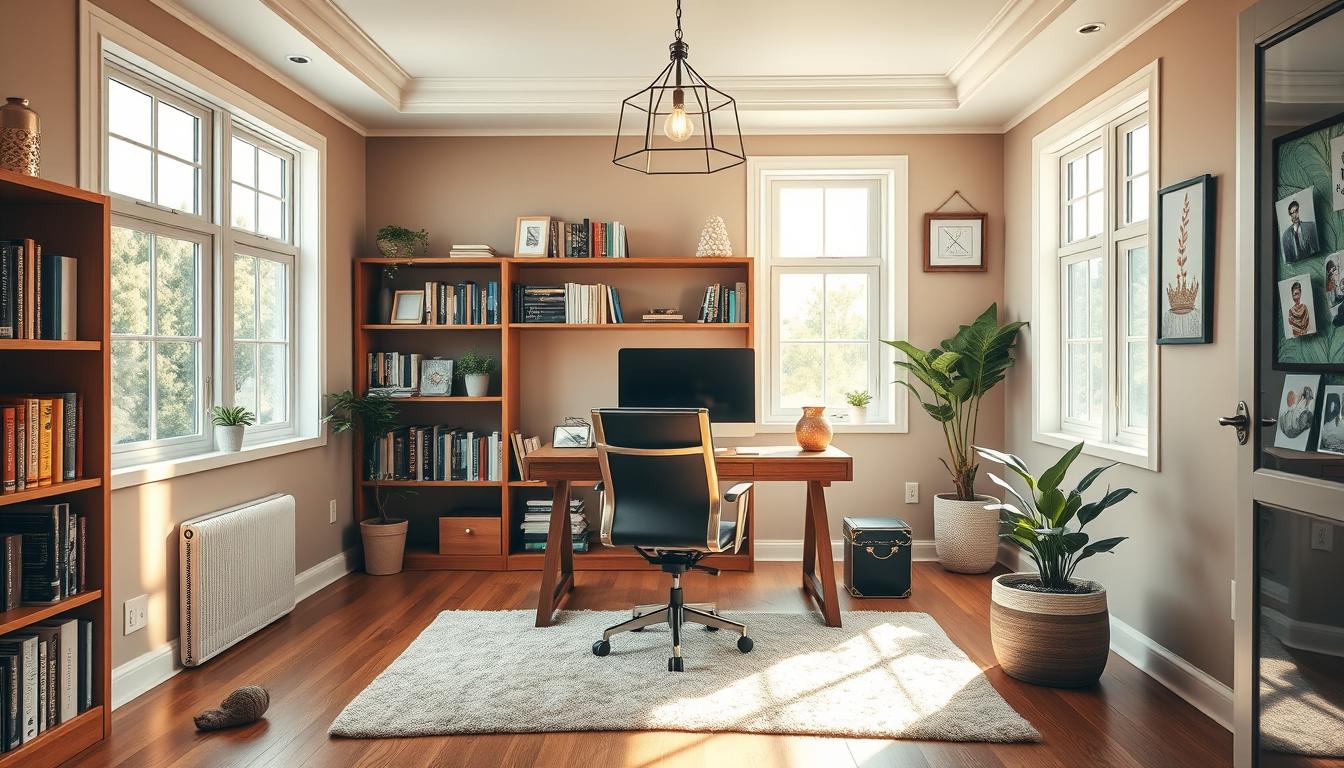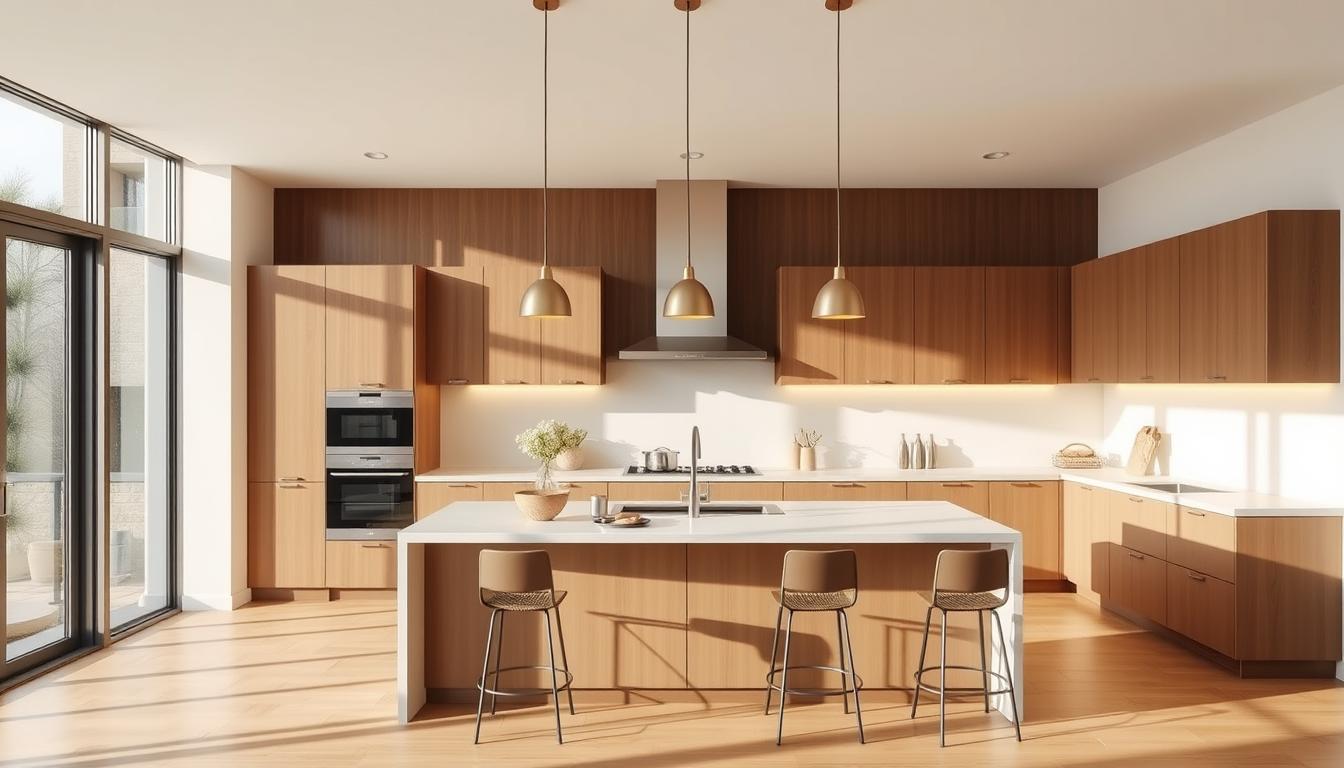With remote work on the rise, having a dedicated workspace at home is key. A well-designed space can greatly improve productivity and well-being.
A productive workspace is more than looks; it’s about creating a space for focus and efficiency. In this article, we’ll share our best tips for designing a home office interior that suits you.
Key Takeaways
- Understand the importance of a dedicated workspace
- Learn how to optimize your workspace for productivity
- Discover design ideas to enhance your work environment
- Get tips on creating a comfortable and ergonomic workspace
- Find out how to minimize distractions and stay focused
Understanding the Importance of Home Office Design
Designing a good home office is more than just picking furniture. It’s about making a space that helps you work better. A well-designed office can really improve how well you work and how happy you are at your job. We’ll look at why home office design is key, its effect on work, and what makes a space work well.
Why a Well-Designed Home Office Matters
A well-designed home office is important for many reasons. It helps you focus better. When your space is tidy, you can pay more attention to your work. Also, a good design adds modern home office decor that can lift your mood and energy.
The Impact on Productivity and Focus
The design and ergonomics of your home office matter a lot for your productivity. An ergonomic home office setup means you can work comfortably for a long time without getting tired or uncomfortable. This includes having the right chair, monitor, and keyboard.
Also, a well-designed office can cut down on distractions. This lets you stay focused on your work.
By spending time on designing your home office, you’re investing in your productivity and well-being. It’s about making a space that fits your work style and helps you reach your goals efficiently.
Choosing the Right Location for Your Home Office
Starting a productive home office begins with picking the right spot. The location you choose greatly affects your work efficiency and job happiness.
Considerations for Space Selection
Several factors are important when picking a spot for your home office. Size is key; you need enough room for your furniture and tools. For a small home office layout, think about using furniture that does more than one thing to save space.
The natural light in the area is also crucial. A bright space can lift your mood and help you work better. But make sure the light doesn’t glare on your screen.
Noise level is another big factor. If your area is loud or you have a big family, you might need to soundproof or use headphones.
Avoiding Common Location Pitfalls
One mistake is putting your office in a busy area. This can be distracting and interrupt your work. Choose a quiet, private spot where you can focus.
Don’t forget about the functional workspace design. Make sure your office layout helps you work well and is comfortable. Your desk should be at a good height, and your chair should support you.
Also, think about how close your office is to things you need. Being too far from a bathroom or kitchen is a hassle. But being too close to a TV or bed can also be distracting.
By thinking about these points and avoiding common mistakes, you can make a functional workspace design. This will help you work better and feel more satisfied with your job.
Essential Furniture for a Productive Workspace
The right furniture can make your home office more productive. A well-designed space boosts efficiency and encourages creativity and comfort.
Desks: Finding the Perfect Size and Height
The desk is key in a home office. It should fit your space and work style. Look for a desk that adjusts height for sitting and standing.
This helps avoid health issues from too much sitting. For a stylish home office furniture look, choose desks with simple designs and less clutter. A desk that’s too big can make a small room feel cramped. A desk that’s too small might not give you enough room to work.
Ergonomic Chairs for Comfort and Support
An ergonomic home office setup needs a comfy, supportive chair. Ergonomic chairs help keep your posture right, reduce body strain, and offer long-lasting comfort. Find a chair that adjusts in height and lumbar support to fit your body.
Choose a chair with breathable fabric and good cushioning for comfort. Good seating boosts your productivity and well-being. For more tips on setting up a home office, check out our guide on crafting a stylish and functional home.
Optimizing Lighting in Your Home Office
Optimizing lighting in your home office can greatly improve your work experience. Proper lighting does more than just help you see. It also affects your mood, energy, and productivity.
When setting up a modern home office decor, think about lighting. Natural light is best because it boosts vitamin D and helps our body clocks.
The Role of Natural Light
Natural light is key for a welcoming and productive home office interior. “A well-lit room can make all the difference in how you feel and work,” says a famous interior designer.
To get the most natural light, place your desk near a window. Use sheer curtains or blinds to adjust the light, making sure it’s not too bright or too dim.

Task Lighting vs. Ambient Lighting
Natural light is great, but sometimes it’s not enough, like in the evening or in rooms with little sunlight. That’s when task and ambient lighting are needed.
Task lighting shines on specific areas, like a desk lamp for reading or working. Ambient lighting lights up the whole room, making it cozy.
To get the right mix, use both task and ambient lighting. For example, a desk lamp (task) with a floor lamp or overhead light (ambient) creates a nice balance.
By improving your home office lighting, you can focus better, reduce eye strain, and make your work experience better. Whether you’re setting up a new home office interior or updating an old one, remember how important lighting is for a productive and comfy space.
Selecting the Right Color Palette
A good color palette can make your home office more productive and creative. The colors you pick can really affect your mood and focus. This can also change how well you work.
Colors to Enhance Focus and Creativity
Colors can influence our mood and behavior. For example, blue helps you stay focused and calm. Green can reduce eye strain and boost concentration. Orange and yellow can spark creativity and energy.
It’s important to think about the psychological effects of different shades. Softer colors can be calming, while brighter ones can energize a space.
How to Use Color Psychology Effectively
To apply color psychology in your office, first think about what you’ll be doing there. If you’ll be writing or coding, blue might be a good choice. For creative tasks, orange or yellow could be better.
It’s also key to balance your colors. Use a main color and add accent colors for a nice look. For example, beige or gray can be the main color, with brighter colors used in furniture or decor.
“Colors are a vital part of our visual experience, and when used thoughtfully, they can greatly enhance our productivity and creativity.”
Here’s a simple table to help you get started with different color options and their effects:
| Color | Effect |
|---|---|
| Blue | Enhances focus and calmness |
| Green | Reduces eye fatigue, improves concentration |
| Orange/Yellow | Stimulates creativity and energy |
| Neutral tones (Beige, Gray) | Creates a balanced and calming background |
By choosing a color palette that fits your work style, you can make a home office that inspires and boosts productivity.
Incorporating Smart Technology into Your Workspace
In today’s world, adding smart tech to your home office is essential. It’s not just a nice-to-have anymore. It’s a must-have for better work-from-home experiences.
Boosting Efficiency with Essential Tech Tools
To make your workspace better, you need the right tech. Here are some key tools:
- High-speed internet routers for uninterrupted connectivity
- Noise-cancelling headphones for improved focus
- Smart printers that can handle multiple tasks
- Cloud storage solutions for secure data management
These tools can really boost your workspace’s efficiency and productivity.
Achieving Seamless Connectivity
Good connectivity is crucial for a productive home office. Here’s how to get it:
- Invest in a reliable Wi-Fi router that can cover your entire workspace.
- Use a Wi-Fi extender if necessary to ensure strong connectivity throughout your office.
- Regularly update your router’s firmware to ensure you have the latest security patches.
By following these tips, you can avoid connectivity problems and keep your workflow smooth.
Technology is key in modern home office decor. It’s not just about looks. It’s about making your space both functional and tech-savvy.
| Tech Tool | Benefit |
|---|---|
| Smart Speakers | Hands-free control and smart home integration |
| Wireless Charging Pads | Convenience and clutter reduction |
| Portable SSDs | Fast data transfer and secure storage |
By carefully choosing these technologies, you can make your workspace efficient and enjoyable.
Adding Personal Touches to Your Home Office
Adding personal touches to your home office can really boost your creativity and productivity. A space that shows your personality can make you work better and enjoy your time more.
When making your home office personal, finding the right balance is key. You want it to be inspiring but still professional enough to keep you focused. Using stylish home office furniture that’s both comfortable and functional is a great way to find this balance.
Balancing Professionalism with Personal Style
To mix professionalism with personal style, add decor that shows your taste but doesn’t mess up the workspace’s function. For example, you could hang some artwork or minimalist home office inspiration pieces that match your interests. As a famous designer once said,
“A room should be an expression of the owner’s personality.”
This quote highlights how important it is to make your home office show who you are.
The Power of Inspirational Decor
Inspirational decor can really help your productivity and motivation. Things like vision boards, motivational quotes, or personal keepsakes can remind you of your goals. When picking out inspirational decor, make sure it fits your work style and doesn’t make your space too busy.
Here are some ideas for inspirational decor:
- A vision board with your goals
- Motivational quotes around your office
- Personal mementos that motivate you
- Plants or flowers for a natural touch
By carefully adding personal touches and inspirational decor, you can make a home office that’s both productive and shows your personality.
Creating a Distraction-Free Environment
To boost productivity in your home office, it’s key to cut out distractions. A well-designed space improves focus and makes your workday more efficient.
Identifying Common Distractions
Home offices face many distractions, like family interruptions or the urge to do household chores. Common distractions include:
- Noise from other parts of the house
- Digital notifications from phones or computers
- Visual clutter and disorganization
- Family interruptions
Spotting these distractions is the first step to reducing them.
Strategies to Minimize Interruptions
After spotting distractions, you can start to lessen them. For example, setting clear boundaries with family can cut down on interruptions. Here are more ways to do it:
- Use noise-cancelling headphones or play background music to mask other noises.
- Implement a “do not disturb” sign during work hours.
- Organize your workspace to reduce visual clutter.
- Schedule specific times to check digital notifications.
These strategies help you focus better and meet your productivity goals.

Creating a distraction-free home office is more than just about work. It’s about making a space that supports your well-being. By knowing common distractions and using smart strategies, you can make working from home better.
Organizing Your Home Office for Maximum Efficiency
Starting an ergonomic home office setup means getting organized. This is key for being productive and efficient.
A tidy home office makes work better. It also helps your overall health and well-being.
Storage Solutions That Work for You
Good storage is the heart of an organized home office. Here are some tips:
- Use wall-mounted shelves and storage units to save space.
- Get a filing cabinet for easy access to important papers.
- Choose a desk with built-in storage to keep things neat.
Now, let’s look at different storage options:
| Storage Solution | Benefits | Space Requirement |
|---|---|---|
| Wall-mounted Shelves | Uses vertical space well, easy to get to | Minimal |
| Filing Cabinets | Keeps documents in order, safe | Moderate |
| Desks with Storage | Helps keep things tidy, convenient | Moderate to High |
The Benefits of Decluttering Regularly
Decluttering often is vital for a tidy and efficient home office. It cuts down on distractions, boosts focus, and increases productivity.
Here are some decluttering tips:
- Set up regular decluttering times.
- Sort items into keep, donate, or discard piles.
- Deal with each paper or item right away.
By following these steps and staying organized, you can make a home office that’s both efficient and productive.
Maintaining a Healthy Work-Life Balance
Working from home can be both a blessing and a challenge. It’s key to keep work and personal life separate. This helps us enjoy our home office without it taking over our lives.
Setting Boundaries in Your Home Office
Working from home can make it hard to separate work from personal time. To fix this, we must set clear boundaries in our home office.
We can do this by setting specific work hours. Having a dedicated workspace helps too. And, we can create rituals to mark the start and end of our workday.
The Importance of Scheduled Breaks
Regular breaks are vital for staying productive and avoiding burnout. They help us recharge and stay focused all day.
Here’s a simple schedule to balance work and breaks:
| Time | Activity |
|---|---|
| 9:00 AM – 9:30 AM | Work |
| 9:30 AM – 9:45 AM | Break |
| 9:45 AM – 12:00 PM | Work |
| 12:00 PM – 1:00 PM | Lunch Break |
This schedule ensures we get enough rest and recharge. It boosts our well-being and productivity over time.
Keeping a healthy work-life balance is a continuous effort. By focusing on our well-being and using strategies like setting boundaries and taking breaks, we can make our home office a better place to work.
Regularly Updating Your Workspace
A well-designed home office is key for staying productive and focused. But, our needs and tastes can shift over time. So, it’s vital to update our workspace regularly to stay on track.
Revitalizing Your Office Design
Updating your home office can be easy. Just add modern decor or stylish furniture that matches your style. This not only makes your space look fresh but also keeps it functional and efficient.
When you decide to redesign, think about what will help your work habits and goals. Adding new tech or rearranging the layout can boost your productivity a lot.
Staying Current with Changing Needs
As our work habits and tastes change, so should our home office. By keeping up with these changes and making adjustments, we can keep our workspace supporting our success.



